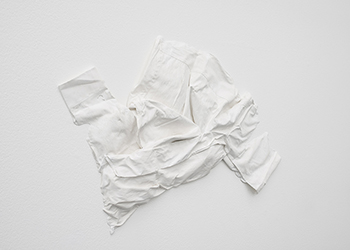Emily Wardill. Matt Black and Rat

Matt Black and Rat is the title of an exhibition by the artist Emily Wardill that is going on display in the Project Space of the Modern Collection of the Calouste Gulbenkian Museum as from 2 June. This sample, produced in partnership with Bergen Kunsthall of Norway, gathers the recent works by this British artist who, since 2012, has lived and worked in Lisbon. This features two new films, a series of sculptural reliefs and an otherwise unseen set of photograms. In this set of works, the artist explores the limits of communication and language, creating narratives to converge reality, fantasia and the supernatural with occasional references to the cinematographic genre of terror films.
The film I gave my love a cherry that had no stone (2016), filmed in the Grande Auditorium Foyer of the Calouste Gulbenkian Foundation, explores the performative relationship between the body and the space and the respective mutual contamination, affirmed both through filmic construction and the film’s exhibition conditions in order to materialise an installation that destabilises the position of the spectator. The film No Trace of Accelerator, co-produced expressly for exhibition in Bergen and in Lisbon, departs from the mysterious events that took place in the 1990s in the small and isolated French city of Moirans-en-Montagne, when a series of fires, apparently spontaneous, and ongoing for a long time and always unexplained, became an object of collective reaction and construction enveloped in fear and in superstition that would later become an anthropological case study. The fire is understood as an action and potential transformer, a core element and catalyst both for the film No Trace of Accelerator and for the set of objects gathered together for this exhibition.
“I work with images that function as words and with words that function as images”
In a short interview, Emily Wardill revealed the core guiding threads to this singular exhibition that has just come off display in the Bergen Kunsthall in Norway.
What does Matt Black and Rat mean to you?
Various things. To begin with, this is the expression used when painting a vehicle matt black and sometimes even with house paint. In doing so, we show we are not interested in the superficial appearance of the car but only in its structural features: the size of the motor, the speed, power, etcetera. My artistic heritage comes from the structuralist directors and hence the emphasis on the materiality that, to me, becomes highly appealing. This specific matt black also resembles a burned car and one of the films included in the exhibition, No Trace of Accelerator, recalls a series of fires. But, above all, I like the way in which the words sound not only separately but also as a whole. In this exhibition, I work images that function as words and words that function as images. And the words that compose this title also closely resemble the images.
What are you showing in this exhibition? What is the key idea?
Some distinct works No Trace of Accelerator is a film made last summer that is based on a series of fires that took place in France in the late 1990s. Fire is encapsulated from the perspective of a case study based on the social amplification of risks. During the occurrence of these fires, the local population went about identifying various factors as responsible: electricity failings, microwaves, earthquakes, and, finally, the supernatural as there was never any evidence of the accelerator found at the location of the fires and having also excluded any criminal origins. I also show a series of sculptured reliefs that are white shirts that seem to emerge from the walls. These sculptures emerge as something between pieces of origami and semi-ghosts. Also on display are the photograms made from the light inspired by the title Matt Black and Rat. Finally, in the last room, I show I gave my love a cherry that had no stone – a film shot in the Gulbenkian – with the ballet dancer David Marques. I don’t know if I can say that there is some key idea but I thought a lot about the idea that something wants to be something else. The case study is materiality that aspires to transparency – is supposed to be forgotten whenever we understand it. Furthermore, the reliefs are like sculptures that want to be flat and the photograms are words that want to be images. Finally, the film I gave my love… is about a man who does not want to be real.
Why did you decide to film in the Gulbenkian Foundation?
In this space, we have the sensation that time points off in two different directions. It would seem the past imagining the future. The textures, the colours, the way in which the light falls, makes us discover the era, the time of day, if we are welcome or not. It’s like some kind of horror classic that feeds off our fear of the unknown. I think about horror from the point of view of our relationship with the objects. The film focuses upon the relationship between a camera and a person that resemble each other – the camera has a human character and the person has the technology of the machine.
What led you to move to Portugal?
I came to Lisbon to participate in a film with Kunsthalle Lissabon a few years ago and I got seduced by the music, the energy, the persons, everything so close to the wild ocean… It seemed to me that without this beautiful and powerful force running the length of the country, this would be an entirely different place.
About the exhibition
